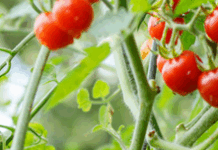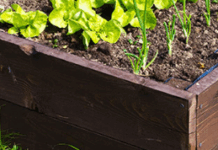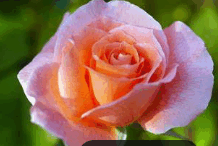https://hnr.k-state.edu/extension/info-center/newsletters/index.html
Blog Post: http://www.ksuhortnewsletter.org
Video of the Week: Common Tomato Problems; Part 1
https://kansashealthyyards.org/all-videos/video/common-tomato-problems-part-1
REMINDERS
• Renovate strawberry beds after last picking of fruit by cutting off leaves, fertilizing and narrowing row to 10 inches. https://tinyurl.com/y7mlwn3k
• Tip blackberries, black raspberries and purple raspberries as needed. See https://www.ksuhortnewsletter.org/newsletters/tip-blackberries-black-raspberries-and-purple-raspberries1349880
VEGETABLES
Hornworms on Tomatoes
Hornworms are the largest larval insect commonly seen in the garden. Though usually seen on tomato, they can also attack eggplant, pepper, and potato.
The larval stage of this insect is a 3 ½- to 4-inch long pale green caterpillar with five pair of prolegs and a horn on the last segment. The two most common hornworms are the tobacco hornworm (seven diagonal white stripes and, most commonly, a red horn) and the tomato hornworm (v-shaped markings with a horn that is often blue or black).
The adult of the tobacco hornworm is the Carolina sphinx moth. The five-spotted hawk moth is the adult of the tomato hornworm. Both moths are stout-bodied, grayish-colored insects with a wing spread of 4 to 5 inches. The larva is the damaging stage and feeds on the leaves and stems of the tomato plant, leaving behind dark green or black droppings.
Though initially quite small with a body about the same size as its horn, these insects pass through four or five larval stages to reach full size in about a month. The coloration of this larva causes it to blend in with its surroundings and is often difficult to see despite its large size. It eventually will burrow into the soil to pupate. There are two generations a year.
This insect is parasitized by a number of insects. One of the most common is a small braconid wasp. Larva that hatch from wasp eggs laid on the hornworm feed on the inside of the hornworm until the wasp is ready to pupate. The cocoons appear as white projections protruding from the hornworm’s body. If such projections are seen, leave the infected hornworms in the garden. The wasps will kill the hornworms when they emerge from the cocoons and will seek out other hornworms to parasitize.
Handpicking is an effective control in small gardens. Though large, these larvae are surprisingly difficult to see. Missing foliage is often the first clue that you have an interloper. Bt (Dipel, Thuricide), spinosad (Conserve; Colorado Potato Beetle Beater Conc; Captain Jack’s Dead Bug Brew, Monterey Garden Insect Spray), cyfluthrin (BioAdvanced Vegetable & Garden Insect Spray) and other insecticides may also be used to control hornworms. Pay attention to the harvest interval. The harvest interval is the number of days between when the spray is applied and when the fruit can be harvested. (Ward Upham)
Physiological Leaf Curl in Tomatoes
Every year we have calls from gardeners who have tomato plants with leaves that curl up. When tomato plants grow vigorously in mild, spring weather the top growth often exceeds the root development. When the first few days of warm, dry summer weather hit, the plant ‘realizes’ that it has a problem and needs to increase its root development. The plant tries to reduce its leaf area by rolling leaves. The leaves curl along the length of the leaf (leaflet) in an upward fashion. It is often accompanied by a thickening of the leaf giving it a leathery texture. Interestingly, leaf roll is worse on some varieties than others.
Though rolling usually occurs during the spring to summer shift period, it may also occur after a heavy cultivating or hoeing, a hard rain, waterlogged soil or any sudden change in weather. This leaf roll is a temporary condition that goes away after a week or so when the plant has a chance to acclimate, recover from injury, or the soil has a chance to dry out. (Ward Upham)
Squash Bugs
Squash bugs are the grey, shield-shaped bugs that feed on squash and pumpkin plants. If you have had problems with these insects in the past, you know that they are almost impossible to control when mature. This is because the squash bugs have a hard body that an insecticide has difficulty penetrating. Thus, spraying when the insects are small is important. Look on the underside of the leaves for cluster of brick-red eggs and small green insects with black legs. These nymphs will eventually become adults, which will lay eggs that will become the second generation. The second generation is often huge and devastating. Therefore, it is important to control as many squash bugs of the first generation as possible.
Because squash bugs feed by sucking juice from the plant, only insecticides that directly contact the insect will work. General use insecticides such as permethrin (Bug-B-Gon Multi-Purpose Garden Dust; Green Thumb Multipurpose Garden and Pet Dust; Bug-No-More Yard and Garden Insect Spray; Eight Vegetable, Fruit and Flower Concentrate; Garden and Farm Insect Control; Lawn & Garden Insect Killer), malathion, and methoxychlor provide control if a direct application is made to young, soft-bodied squash bugs. This means that you MUST spray or dust the underside of the leaves because this is where the insects live. (Ward Upham)
TURF
Controlling Yellow Nutsedge in Lawns
Yellow nutsedge is a relatively common problem in lawns, especially in wet years or in lawns with irrigation. Although sedges look much like a grass, they are different.
Unlike grasses, sedges have triangular stems, and the leaves are three-ranked instead of two-ranked, which means the leaves come off the stems in three different directions. Yellow nutsedge is pale green to yellow and grows rapidly in the spring and early summer. Because of this rapid shoot growth, it sticks up above the rest of the lawn only a few days after mowing. This weed is a good indicator of poor drainage, but it can be introduced into well-drained sites through contaminated topsoil or nursery stock. As with many weeds, nutsedge is less competitive in a dense, healthy lawn than in an open, poor lawn.
Nutsedge is difficult to control culturally because it produces numerous tubers that give rise to new plants. Pulling nutsedge will increase the number of plants because dormant tubers are activated. However, it is possible to control nutsedge by pulling, but you must be persistent. If you are, eventually the nutsedge will die out though this will likely take more than one season.
If you were going to treat with an herbicide, it would be better to leave the nutsedge plants undisturbed so the herbicide can be maximally translocated to the roots, rhizomes, and tubers. Several herbicides are available for nutsedge control.
SedgeHammer and Hi-Yield Nutsedge & Horsetail Control contain halosulfuron and are effective and safe products. The SedgeHammer label says to apply after the nutsedge has reached the three- to eight-leaf stage. Waiting until this growth stage apparently results in improved translocation of the active ingredient to the underground tubers and rhizomes.
Products with sulfentrazone such as Bonide Sedge Ender, Ortho Nutsedge Killer and Spectracide Weed Stop for Lawns Plus Crabgrass Killer are also effective.
Research has shown that the first application should go down by June 21. If the initial spray is after June 21, mature daughter tubers may be stimulated to grow. (Ward Upham)
Grub Control in Lawns
If you plan on using a grub preventative on your lawn, the first half of July is a good target date for most products. Preventatives are normally used on areas that have had a history of grub problems.
Traditional grub insecticides such as Dylox or carbaryl (Sevin) are normally applied in late July after grubs are present or as a rescue treatment once damage is seen. Products that contain Merit (imidacloprid) are considered grub preventers. Actually, these products do not prevent grubs, but rather kill grubs when they are quite small, and long before they cause damage. Merit is safer to use around pets and humans than traditional grub killers. Merit can be found in BioAdvanced Season-Long Grub Control, Bonide Grub Beater, Gordon’s Grub No-More and Hi-Yield Grub Free Zone II and III.
Another grub preventer with the trade name GrubEx contains chlorantraniliprole. Though this product is very effective, it is less water soluble than imidacloprid. It should be applied earlier, preferably April or May, but applications through June should still be effective. Remember, all grub products should be watered in soon after application. (Ward Upham)
MISCELLANEOUS
Stress to Trees and Shrubs is Cumulative
Stress is cumulative. In other words, trees and shrubs can be affected by stresses that happened up to several years in the past. Recent stresses in Kansas include sharp drops in temperature in the fall before some trees had hardened off. This occurred in both 2019 and 2020. This was followed by last fall and winter’s extremely dry weather which often resulted in damaged root systems. This damaged root system may have been further weakened due to too much rain in some part of the state this spring. The excess water harmed root systems due to saturated soils driving out oxygen. Roots need oxygen as much as they need water. Though the roots were able to keep up with moisture demands during the cooler spring weather, they may not be able to keep up when the weather turns hot and dry. Such trees and shrubs may suddenly collapse and die or slough off branches they can no longer support.
This does not mean that all of our plants are doomed. Some plants are just better adapted to our tough Kansas conditions and have suffered little to no harm. However, it is a good idea to check the overall health of your trees. So how do you tell?
One of the most important clues in determining the health of your trees is the amount of new growth that tree has produced. A healthy tree should have a minimum of 4 to 6 inches of new growth each year and usually much more. Check branches with the tips in the open and not shaded by the tree itself. Anything less than 4 inches on the majority of branches suggests the tree is under a great deal of stress. We had an article in this newsletter last week that showed what to look for.
The only thing poor growth tells you is whether a tree is under stress or not. It does not tell you what is causing or has caused poor growth. This year, the most common cause by far is environmental stress caused by the dry fall and winter followed by excessive rain this spring.
So, what do we do for trees under stress? The most important practice is to water as needed. See last week’s newsletter for information on proper watering practices. (Ward Upham)
Contributors: Ward Upham, Extension Associate
Division of Horticulture
1712 Claflin, 2021 Throckmorton
Manhattan, KS 66506
(785) 532-6173
For questions or further information, contact: wupham@ksu.edu OR cdipman@ksu.edu
This newsletter is also available on the World Wide Web at: http://hnr.k-state.edu/extension/info-center/newsletters/index.html
The web version includes color images that illustrate subjects discussed. To subscribe to this newsletter electronically, send an e-mail message to cdipman@ksu.edu or wupham@ksu.edu listing your e-mail address in the message.
Brand names appearing in this newsletter are for product identification purposes only. No endorsement is intended, nor is criticism implied of similar products not mentioned.
K-State Research and Extension is committed to making its services, activities and programs accessible to all participants. If you have special requirements due to a physical, vision or hearing disability, or a dietary restriction please contact Extension Horticulture at (785) 532-6173.
Kansas State University Agricultural Experiment Station and Cooperative Extension Service K-State Research and Extension is an equal opportunity employer. Issued in furtherance of Cooperative Extension Work, Acts of May 8 and June 30, 1914, as amended. Kansas State University, County Extension Councils, and United States Department of Agriculture
Cooperating, Ernie Minton, Dean.





